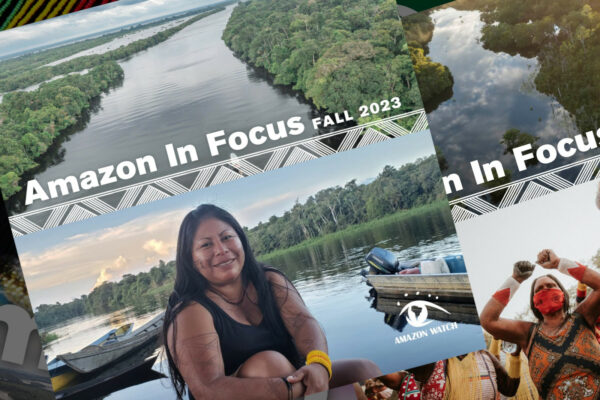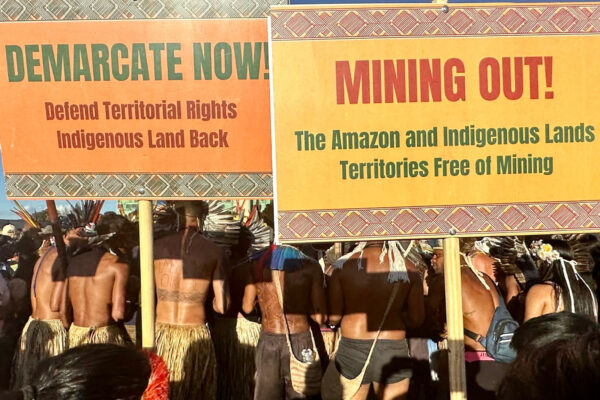Washington – The spraying of chemical herbicides to destroy coca fields in southern Colombia could seriously threaten the rainforests and wildlife of the Amazon and the health of indigenous and small farming communities, warned scientists and indigenous leaders here.
As part of a 1.6 billion dollar US emergency aid package to Colombia, the South American country is preparing to undertake a large-scale fumigation of illicit coca plants using the herbicide glyphosate.
Indigenous leaders, at a press conference here Monday, said the use of glyphosate, manufactured by the US-based company Monsanto, is not stopping coca from being grown. Instead, it is killing their food crops and causing a series of health problems and water contamination.
“The fumigation has caused damage to our yuca and sugarcane crops and has caused sickness in our children,” said Francisco Tenorio, president of the Regional Indigenous Organisation of Putumayo, a region in Colombia.
In Putumayo and other regions, including Guaviare, Meta and Caqueta, communities have reported that indiscriminate fumigation has caused illnesses, destroyed pastures and food crops, poisoned livestock and contaminated water supplies, he said.
Emperatriz Cahuache, president of the Organisation of Indigenous Peoples of the Colombian Amazon, displayed a map illustrating how the areas of coca and marijuana cultivation overlaps with indigenous territories and the areas that have been fumigated.
“These fumigations are contaminating the Amazon and destroying the forest,” said Cahuache.
Photos taken in Colombia displayed at the press conference showed food crops destroyed by fumigation along side thriving coca plants that somehow escaped the herbicide.
While supporters of the aerial spraying say glyphosate is no more harmful than table salt, Elsa Nivia, director of the Colombian affiliate of the Pesticide Action Network, an environmental advocacy group, said the herbicide is “toxic” to all plants.
“It is impossible to say that this herbicide can be applied in a way that is not harmful to the environment,” she said.
In the United States, the Environmental Protection Agency’s own study on the herbicide published in 1993 noted that in California, a state that is required to report pesticide poisonings, glyphosate was ranked third out of the 25 leading causes of illness or injury due to pesticides.
Labels on glyphosate products in the United States advise users to avoid applying it to any body of water.
Nivia warned that the ecological impacts of the pesticide in the Amazon is not completely known since it has not been tested in a tropical ecosystem..
David Olson, director of the conservation science programme at the World Wildlife Fund (WWF), compared the effects of spraying glyphosate in Colombia with the use of Agent Orange during the US war with Vietnam.
He said both caused large areas of forest to be contaminated and stripped of their leaves, causing a loss of habitat for species and increased fragmentation of intact forests.
“From a global bio-diversity perspective, defoliating and poisoning vast areas of Colombian forests is like dynamiting the Taj Mahal, a global jewel of humanity’s cultural heritage,” said Olsen.
Aquatic ecosystems are particularly sensitive to glyphosate and wildlife, especially frogs and insects will be directly affected, he said.
“Many will die from contact with the spray,” he said. “The loss of habitat, foods, shelter, moisture and soil nutrients will affect all species.”
The survival of Colombia’s abundant bird species is also at risk from the fumigation, according to Luis Naranjo, director of international programmes at the American Bird Conservancy, a US advocacy group.
He said a recent scientific study of a part of Putumayo, confirmed that about 500 bird species were living in the region that is now the main target of the drug eradication campaign.
“Unless the current policies to face the drug problem in the country are revised, we will be facing the extinction of many of the organisms that make the country’s biota so distinctive,” said Naranjo.
Human rights activists and Colombian drug policy analysts at the press conference said there is strong evidence that aerial fumigation and other source control efforts are ineffective at curbing overall drug production and reducing drug use in the United States.
Even though the Colombian government fumigated coca and poppy from 1992 to 1999, the country remains the world’s leading producer of coca, said Ricardo Vargas, a sociologist with Accion Andina, a Colombian- based organisation that researches the impact of counter-narcotics policies.
“Despite these realities, Colombia is preparing to repeat yet again a policy that has failed repeatedly,” he said.
Sanho Tree, director of the drug policy project with the Institute for Policy Studies, criticised the focus on drug eradication, interdiction and law enforcement.
He pointed to a study by the RAND Corporation, a California-based think-tank, which found that dollar for dollar, providing drug treatment to cocaine users in the United States is 10 times more effective than drug interdiction programmes and 23 times more cost effective than trying to eradicate coca at its source.
“If decreasing drug use is our ultimate goal, why aren’t we putting more resources into our woefully under-funded domestic drug treatment programmes where each dollar spent is 23 times more effective?” asked Tree.
# # # .













